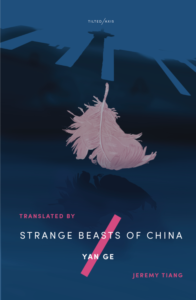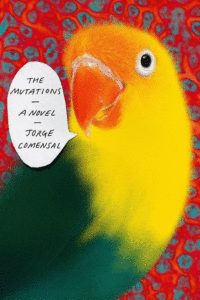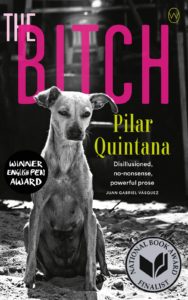
As some of you may remember, my last Valentine’s Day column was a little… dark. Since then, though, the lump of coal in my chest has been warmed by the love of the world’s goofiest, snuggliest, most sonorously flatulent hound—a mystery mix of uncertain age named Camila, without whom I might not have changed out of my pajamas at all these past nine months.
This year’s V-Day column is a love letter to all the beasties in our lives—from the IRL antics of our furry (or feathered, or scaly) roommates, to the seemingly endless supply of critter content on the interwebs, which has been a balm for so many. Reader, what is essential viewing if not these baby goats in onesies, this panda playing in snow, this Twitter account? Or this late entry, which, though technically not an animal video, will live in my heart for all time.
But animals haven’t just been enjoying a good run in memes; they’ve also been all over translated literature lately. Here are a few of my recent favorites:

Strange Beasts of China by Yan Ge, trans. Jeremy Tiang
Tilted Axis Press (November 2020)
“Other than that, they resemble humans.” Each chapter of this singular book by Yan Ge begins with a physical description of one of the “strange beasts” living in and around the city of Yong’an—sorrowful and joyous beasts, heartsick beasts, prime and returning beasts—and this refrain, which typically follows a fanciful list of traits like colorful gills and feathers or spurs, and sets up the beasts’ complex relationship with the humans they live among. Through the novel’s protagonist, a former zoologist who turned her back on an apprenticeship with the foremost authority on beasts to write fiction about them (the contrast between the ethics of science and art is a rich motif throughout), we observe how the lives of beasts and humans are inextricably intertwined, though the latter repeatedly expel, exploit, or kill the former en masse. I don’t know if it was the unexpected twists and turns in the protagonist’s storyline, or Tiang’s playful-yet-searing English, or the mirror this book holds up to our willingness to be divided and conquered, but I simply could not put this one down.
Double take: this excellent review by Jacqueline Leung for Cha Journal, plus—bonus!—Tiang interviews Yan over at The Center for the Art of Translation (complete with a link to an excerpt from the book).

The Mutations by Jorge Comensal, trans. Charlotte Whittle
Farrar, Straus & Giroux (November 2019)
When high-powered lawyer Ramón Martínez is diagnosed with a highly unusual form of cancer and undergoes a complete glossectomy, he bids farewell to his quick tongue in the courtroom and his taste for spicy foods, along with other select lingual activities. As the cancer takes over Ramón’s body and domestic life, he develops an unexpected friendship with the half-bald, foul-mouthed parrot that his devoted housekeeper, Elodia, picked up for his birthday. This impressive debut novel manages to be both a deeply moving and darkly humorous meditation on self-discovery in the face of a devastating disease. It’s also a masterpiece of choral storytelling (we dip in and out of the perspectives of not only Ramón and his family, but also of his marijuana-cultivating therapist and weeeeeird oncologist, among others). And the parrot’s unexpected expletives are not to be missed.
Double take: here’s the Book Marks round-up, and here’s a snippet over at Lit Hub.

The Story of a Goat by Perumal Murugan, trans. N. Kalyan Raman
Grove/Black Cat (December 2019)
Six years ago, Perumal Murugan was forced to flee his hometown after One Part Woman (nominated for National Book Award) sparked violent protests among religious conservatives. The Story of a Goat (also nominated for a National Book Award) was written from “beyond the grave,” as it were, and it certainly has an otherworldly quality—even as it takes a long, hard look at life in the arid region of Kongu Nadu. The novel’s titular goat, a sweet, sickly little kid, is given to an old farmer and his wife, who already have trouble scraping together enough food for themselves. They somehow manage to nurse the little kid to health and she grows into a happy young goat with a surprisingly rich inner life. But make no mistake, it’s not all frolicking and munching: through the eyes of this little animal, Murugan explores the extreme precarity, lethal bureaucracy, and undercurrent of violence that shape the world in which she moves.
Double take: Parul Sehgal reflects on this “powerful parable” for The New York Times.

The Hole by Hiroko Oyamada, trans. David Boyd
New Directions (October 2020)
When Asahi’s husband is transferred from the big city to a village near where he grew up, the young couple move into his parents’ rental unit, serendipitously vacated weeks earlier. The charm quickly wears off their new surroundings: the husband is completely absent, always either at work or staring at his phone, and the in-laws are always present, buzzing around as irritatingly as the cicadas during those sticky summer days. The unmistakable sensation we get from this cloying, humid mess is the claustrophobia induced by the lot of the housewife—a role described by older generations as an endless summer vacation, but which takes a decidedly unheimlich turn when Asahi comes into contact with the wolflike creatures that dig enormous holes along the river bank, just deep enough for a person to fall in up to their neck. Unluckily for Asahi, it turns out that the mystery of these beasts is no match for the mystery of what lies behind closed doors in the suburbs.
Double take: Iain Maloney on why “Kafkaesque” isn’t just lazy shorthand in this case.

The Bitch by Pilar Quintana, trans. Lisa Dillman
World Editions (August 2020)
Pilar Quintana, who was just awarded the prestigious Alfaguara Prize, really knocked me on my ass with this one. I have no idea how she managed to pack so much psychological nuance and political force into this slender novel. Yuri Herrera may have put it best: “Artist that she is,” he writes, “Pilar Quintana uncovers wounds we didn’t know we had, shows us their beauty, and then throws a handful of salt into them.” Though she is still reeling from a childhood trauma shot through with the brutal inequities of race and class, Damaris is desperate to start a family of her own with her generally cantankerous husband, Rogelio. Their sustained attempts with fertility treatments, however, haven’t taken. Enter the newborn puppy rescued from certain death and handed unceremoniously to Damaris on the beach of the small Colombian town where she lives. I don’t want to ruin any surprises, but the complexity of Damaris’s and Rogelio’s reactions to the animal’s pregnancy later in the novel is one of the most astute portraits of the beautiful and the beastly in our natures that I’ve read in a long, long time.
Double take: Charlotte Mackenzie de Urrea on the “love, loss, and violence,” of this gem, and here’s an excerpt on Lit Hub.
*
Shameless plug: Betina González’s American Delirium, which I translated and absolutely love, comes out on Tuesday! It’s a crazy novel about the breakdown of capitalist society, told in three voices and featuring hallucinogens and rampaging deer.

